Trap Hills looking east to Norwich Bluff
June 24, 2025
Protecting Nature in Michigan
Michigan is home to many special places and diverse wildlife. ELPC is working to ensure both are protected.
By Kelly Thayer, Senior Policy Advocate
This month, ELPC is working to protect the Trap Hills from logging in the Western UP, a key area in the Keep the UP Wild campaign. And we had an important victory to protect the Kirtland’s warbler songbird in the upper part of lower Michigan.
THE TRAP HILLS
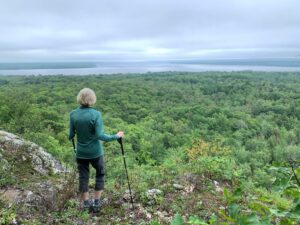
Hiker in the Upper Peninsula’s Trap Hills
Since mid-2021, we and our partners have built a 350-member strong Keep the U.P. Wild coalition advocating to protect four areas covering more than 50,000 acres of the Ottawa National Forest (ONF) as Wilderness in the Western Upper Peninsula. Recently, the ONF released a Draft Decision to proceed with its North Victoria Vegetation Management Project, which includes logging thousands of acres of the Trap Hills proposed Wilderness.
The 25,000-acre Trap Hills is a rare gem worthy of Wilderness protection. The U.S. Forest Service heralds its “large tracts of undisturbed forest, rugged slopes and ridges, streams, waterfalls and ponds [offering] solitude and [a] sense of remoteness that is unique in the Great Lakes area.”
A year ago, eight Keep the U.P. Wild coalition members submitted joint comments requesting that the ONF preserve the potential of the Trap Hills to be designated as federal Wilderness by removing it from inclusion in the North Victoria Vegetation Management Project or, at the very least, ensuring any work in the Trap Hills would not impair the Wilderness qualities of the area. And now we are weighing in again.
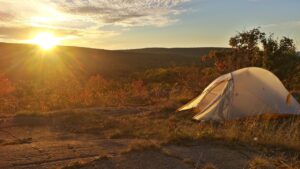
Campsite at the Upper Peninsula’s Trap Hills
Because the ONF indicated in its written response to our prior comments and again in the Draft Decision that it intends to proceed with logging in the Trap Hills, seven coalition-member businesses and organizations, including ELPC, on Monday filed an objection with the Ottawa National Forest. We specifically requested that the ONF use its authority to delay implementation of selection-cut and clear-cut logging for at least 10 years for the 6,137 acres in which the proposed Wilderness area overlaps with the Trap Hills to preserve the opportunity for future Wilderness designation of the area by Congress.
In addition, 32 organizations and businesses from across the U.P. and lower Michigan on Monday submitted a letter of support for Keep the U.P. Wild’s objection asking the ONF to either cancel or at least postpone any logging in the Trap Hills to preserve the ability to become Wilderness in the future.
Residents of Michigan’s Western Upper Peninsula and visitors alike highly value the Trap Hills for its scenic beauty, spectacular views from Michigan’s highest sheer cliff, vast conifer and hardwood forest, abundant hunting and fishing opportunities, and popular hiking access along segments of the North Country National Scenic Trail.
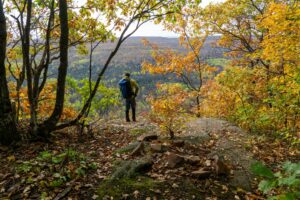
Trap Hills, Upper Peninsula, Michigan
Protecting the Trap Hills will help fight fragmentation and climate change and promote biodiversity in an area known for its rare and endangered species like gray wolves, moose, peregrine falcons, northern goshawks, and wood turtles. The area also features a diverse array of flora, including species like Braun’s holly fern and fairy bells (Prosartes hookeri), which Michigan lists as “threatened” and, east of the Rocky Mountains, is found only in Gogebic and Ontonagon Counties in the Western Upper Peninsula.
Preservation of the Trap Hills also will bolster the Western U.P.’s multimillion-dollar outdoor recreation and tourism economy by enshrining special forms of recreation like hiking, camping, rock climbing, hunting, fishing, birding, kayaking, and snowshoeing – while prohibiting motorized vehicles and logging. Growing the outdoor recreational economy in all seasons is essential here given the region’s long-term declining population and job base and less reliable winters due to climate change.
Stay tuned as the Keep the U.P. Wild coalition awaits a formal response from the Ottawa National Forest to our objection and the public expression of support for protecting the untamed Trap Hills so that current and future generations may one day enjoy the majestic area as permanently protected federal Wilderness.
PROTECTING THE KIRTLAND’S WARBLER IN NORTHERN MICHIGAN
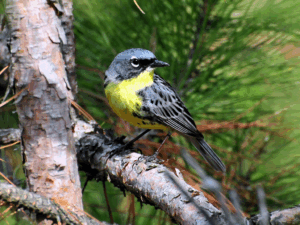
Kirtland’s warbler
The Kirtland’s warbler is an adorable and rare songbird that was one of the first to be listed as endangered after the Endangered Species Act of 1973 and only came off the list in 2019. It breeds only in young jack pine forests in Michigan and adjacent parts of Wisconsin and Ontario, Canada.
As a result of ELPC legal advocacy, the U.S. Fish and Wildlife Service’s (FWS) approval of a right-of-way permit renewal for a pipeline company in Michigan will now include protections for the once nearly extinct Kirtland’s warbler. We identified this issue, and ELPC was the only party to comment on a proposed plan by the FWS to renew the 30-year right-of-way for the Saginaw Bay Pipeline Company that’s located within the Kirtland’s warbler Wildlife Management Area in Ogemaw County, Michigan.
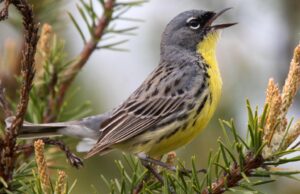
Kirtland’s warbler
The Kirtland’s Warbler Wildlife Management Area is located throughout the northern part of the Lower Peninsula of Michigan in Presque Isle, Montmorency, Oscoda, Ogemaw, Crawford, Kalkaska, Roscommon and Clare counties, and in several counties in the Upper Peninsula as well.
Based upon ELPC’s comments, the FWS agreed to modify the right-of-way permit renewal, also known as a “Compatibility Determination”, to include clearer stipulations to protect wildlife and habitat over the full term of the renewal period. A big win!
KEEP SPECIAL PLACES SPECIAL
The Upper Peninsula and Northern Michigan are indeed among our most special places in the Midwest, and these cherished areas must retain their unique qualities for future generations to enjoy as much as we do today. We will advocate on all fronts to ensure the health and protection of our lands and the biodiversity of flora and fauna that depend on it.


